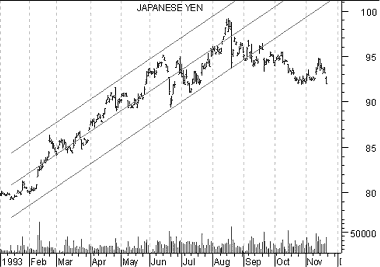
Technical Analysis from A to Z
by Steven B. Achelis
LINEAR REGRESSION LINES
Overview
Linear regression is a statistical tool used to predict future values from past values. In the case of security prices, it is commonly used to determine when prices are overextended.
A Linear Regression trendline uses the least squares method to plot a straight line through prices so as to minimize the distances between the prices and the resulting trendline.
Interpretation
If you had to guess what a particular security's price would be tomorrow, a logical guess would be "fairly close to today's price." If prices are trending up, a better guess might be "fairly close to today's price with an upward bias." Linear regression analysis is the statistical confirmation of these logical assumptions.
A Linear Regression trendline is simply a trendline drawn between two points using the least squares fit method. The trendline is displayed in the exact middle of the prices. If you think of this trendline as the "equilibrium" price, any move above or below the trendline indicates overzealous buyers or sellers.
A popular method of using the Linear Regression trendline is to construct Linear Regression Channel lines. Developed by Gilbert Raff, the channel is constructed by plotting two parallel, equidistant lines above and below a Linear Regression trendline. The distance between the channel lines to the regression line is the greatest distance that any one closing price is from the regression line. Regression Channels contain price movement, with the bottom channel line providing support and the top channel line providing resistance. Prices may extend outside of the channel for a short period of time. However if prices remain outside the channel for a longer period of time, a reversal in trend may be imminent.
A Linear Regression trendline shows where equilibrium exists. Linear Regression Channels show the range prices can be expected to deviate from a Linear Regression trendline.
The Time Series Forecast indicator displays the same information as a Linear Regression trendline. Any point along the Time Series Forecast is equal to the ending value of a Linear Regression Trendline. For example, the ending value of a Linear Regression trendline that covers 10 days will have the same value as a 10-day Time Series Forecast.
Example
The following chart shows the Japanese Yen with a Linear Regression Channel.

Calculation
The linear regression formula is:
![]()
Where:


![]()
Contents
- Preface
- Acknowledgments
- Terminology
- To Learn More
- Bibliography
- About the Author
- Technical Analysis
- Price Fields
- Charts
- Support & Resistance
- Trends
- Moving Averages
- Indicators
- Market Indicators
- Line Studies
- Periodicity
- The Time Element
- Conclusion
- Absolute Breadth Index
- Accumulation/Distribution
- Accumulation Swing Index
- Advance/Decline Line
- Advance/Decline Ratio
- Advancing-Declining Issues
- Advancing, Declining, Unchanged Volume
- Andrews' Pitchfork
- Arms Index
- Average True Range
- Bollinger Bands
- Breadth Thrust
- Bull/Bear Ratio
- Candlesticks - Japanese
- CANSLIM
- Chaikin Oscillator
- Commodity Channel Index
- Commodity Selection Index
- Correlation Analysis
- Cumulative Volume Index
- Cycles
- Demand Index
- Detrended Price Oscillator
- Directional Movement
- Dow Theory
- Ease of Movement
- Efficient Market Theory
- Elliott Wave Theory
- Envelopes (Trading Bands)
- Equivolume/Candlevolume
- Fibonacci Studies
- Four Percent Model
- Fourier Transform
- Fundamental Analysis
- Gann Angles
- Herrick Payoff Index
- Interest Rates
- Kagi
- Large Block Ratio
- Linear Regression Lines
- MACD
- Mass Index
- McClellan Oscillator
- McClellan Summation Index
- Median Price
- Member Short Ratio
- Momentum
- Money Flow Index
- Moving Averages
- Negative Volume Index
- New Highs-Lows Cumulative
- New Highs-New Lows
- New Highs/Lows Ratio
- Odd Lot Balance Index
- Odd Lot Purchases/Sales
- Odd Lot Short Ratio
- On Balance Volume
- Open Interest
- Open-10 TRIN
- Option Analysis
- Overbought/Oversold
- Parabolic SAR
- Patterns
- Percent Retracement
- Performance
- Point & Figure
- Positive Volume Index
- Price and Volume Trend
- Price Oscillator
- Price Rate-of-Change
- Public Short Ratio
- Puts/Calls Ratio
- Quadrant Lines
- Relative Strength, Comparative
- Relative Strength Index
- Renko
- Speed Resistance Lines
- Spreads
- Standard Deviation
- STIX
- Stochastic Oscillator
- Swing Index
- Three Line Break
- Time Series Forcast
- Tirone Levels
- Total Short Ratio
- Trade Volume Index
- Trendlines
- TRIX
- Typical Price
- Ultimate Oscillator
- Upside/Downside Ratio
- Upside/Downside Volume
- Vertical Horizonal Filter
- Volatility, Chaikin's
- Volume
- Volume Oscillator
- Volume Rate-of-Change
- Weighted Close
- Williams' Accumulation/Distribution
- Williams' %R
- Zig Zag